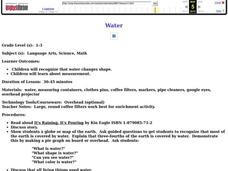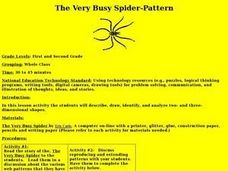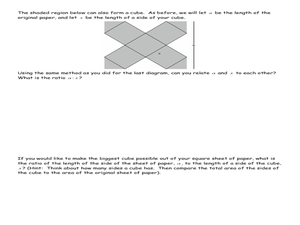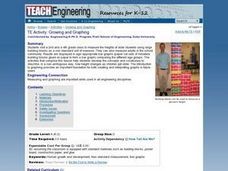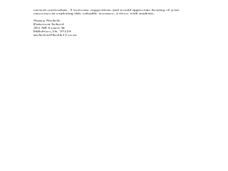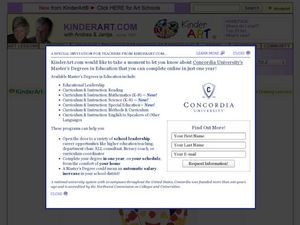Curated OER
Water
Learners complete activities to examine the properties of water. In this water science lesson, students read a book about water's forms and study a map or globe of the Earth to investigate water. Learners discuss living things that need...
Curated OER
The Very Busy Spider-Pattern
Students explore two- and three-dimensional shapes. In this very busy spider lesson, students read the story and then create a spider web pattern of their own. The webs must use a symmetrical pattern. Additional activities...
Curated OER
Applications of Hyperbolas
In this hyperbola activity, 10th graders solve and complete 6 different problems. First, they determine the cross-section of a hyperbolic paraboloid curve. Then, students find where the cone intersects the ground in hyperbola as...
Curated OER
Carving Mountains
Students explore geography by participating in an illustration activity. For this land-form lesson, students define vocabulary terms associated with glaciers and forests. Students utilize pens, cardboard and pottery clay to draw and...
Curated OER
Irregular Word Fluency, Word Baseball
Students review irregular words and build fluency by playing a game. In this irregular word lesson, students label a variety of blank index cards, then post the index cards around the room as signs that create a...
Curated OER
Go Fish for Antonyms
Third graders, after reading and discussing the book, "One Fish Two Fish," by Dr. Seuss, practice matching pairs of antonyms together with an accuracy of 12 out of 15. They make flashcards in the shape of fish to study with and play a...
Curated OER
Origami Cube
Learners compare two lengths using the area of a square. In this geometry lesson, students solve problems using ratio and proportion of the two shapes. They solve equations by taking the square root of both sides.
Curated OER
Tempera Batik
Students utilize elements and principles of design and develop strong composition. They explore colors, contrast and simplification of forms. They sketch in pencil, then trace in chalk before applying their paint.
Curated OER
Learning Cycle Lesson Plan #6 (Misconception)
Ninth graders investigate evolution via natural selection and form an opinion. They support their opinion using scientific evidence and apply this to adaptations that have allowed certain organisms to survive.
Curated OER
Footprint Detectives: Making Inferences Using Dinosaur Trackways
Young scholars analyze and discuss footprints and dinosaur tracks. They listen to books about paleontologists, create and analyze their own trackways using black paper and chalk, examine the data, and form hypotheses about footprints and...
Curated OER
Creating a Leaf Collection and Classroom Herbarium
Students categorize leaves they collect from trees outdoors by consulting a variety of sources. They discuss how the form of a leaf reflects its adaptation to its environment.
Curated OER
Geography General Space
Students use jump ropes to form the state or country of the teacher's choice. When they finish, all students stand around the capital of the state
Curated OER
A Full Military Experience
Eighth graders watch electronic field trip entitled Call to Arms, and simulate daily life of eighteenth-century soldier, including marching, camp building, cannon firing, and sharing common meal. Student groups form regiments by signing...
Curated OER
Growing and Graphing
Students visit a 2nd and a 4th grade class to measure the heights of older students using large building blocks as a non-standard unit of measure. They can also measure adults in the school community. Results are displayed in...
Curated OER
The Geographic Question
Learners are introduced to the characteristics of a river system. In groups, they discover how rivers are formed and how it flows. They discuss the relationship between the river system and people and develop ways to keep the river...
Curated OER
Why is the Middle East so Stereotyped in the West?
High schoolers examine the stereotypes used to classify the Middle East. After taking a regional literacy survey, they discover their own global awareness. They discuss how stereotypes are formed and how they persist over time if not...
Curated OER
Mouthwatering Mollusks
Students investigate various forms of aquatic life. They use four senses, touch, taste, smell, and observation to explore mollusks. Students cook and taste various types mollusks, such as mussels, scallops, and squid.
Curated OER
Kolam: A Living Art of South Asia
Middle schoolers will read the short story "Meenakshi's Magic Hands" by Santhini Govindan and view a slide show of photo images interspersed with the text to learn of the art form of Kolam. Students read and reflect upon a nonfiction...
Curated OER
Traditional Mexican Paper Cutting
Students examine the art form of Mexican paper cutting and discover how to make a pattern. After reading the book "Look What Came From Mexico", they discuss Mexican folk art and view some samples. Individually they create a Mexican...
Curated OER
Class of Cards
Students create patterns using images of everyday objects, shapes, or colors and four logos for use in a House of Cards. For this design lesson, students examine the work of Charles and Ray Eames and become familiar with the elements and...
Curated OER
Creating Sand Dunes
Students explain how sand dunes are formed, the different circumstances that effect the movement of or formation of sand dunes, and relate the information gathered to soil conservation. In this sand dunes lesson plan, students use pans...
Curated OER
Stain Glass
Young scholars study the history of stain glass. In this stain glass lesson, students select an art period and research the use of glass during that time. Young scholars create a picture presentation of stained glass pictures from their...
Curated OER
Fruit and Vegetable Portraits
Students create complex forms from simple items. In this portrait lesson, students examine the work of artist, Giuseppe Arcimboldo and compose self-portraits using vegetables and fruits as features on the face.
Curated OER
Writing Numbers
In this number 7 activity, students write the number in numerical form, word form, and in a sentence. Students complete 5 lines.
Other popular searches
- Geometric Formulas
- Solving Geometric Formulas
- Art Shape and Form
- Use Geometric Formulas
- Art and Music Shape and Form
- Design Element, Shape and Form
